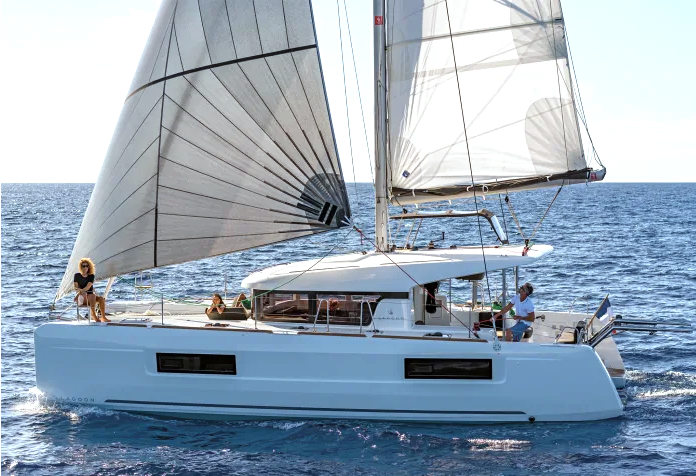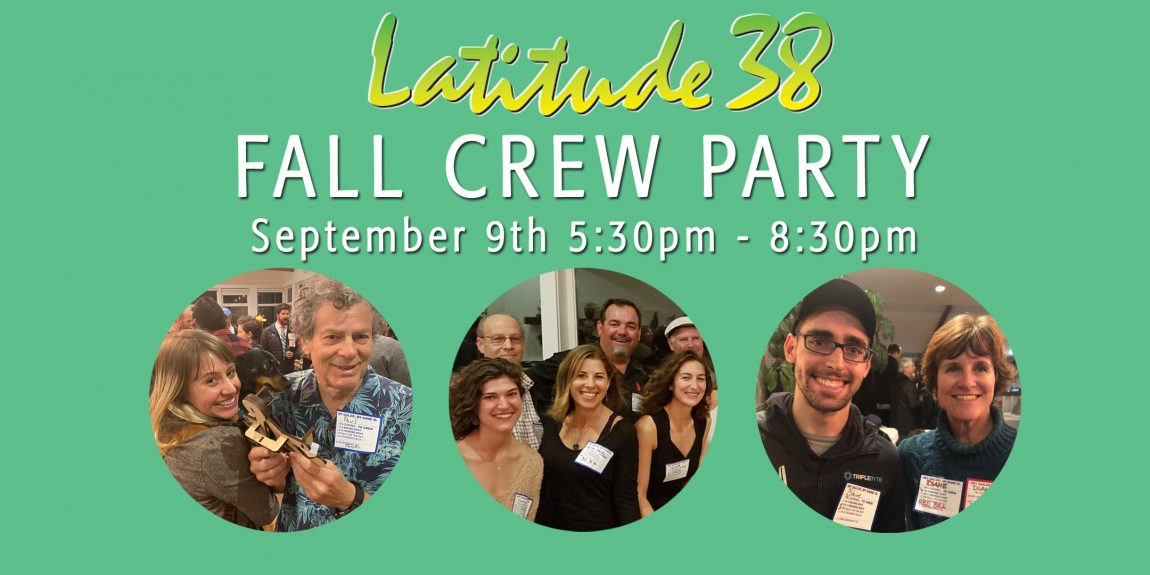
Welcome to Latitude 38’s Sailing Podcast: Good Jibes
A lot has changed since March 1977, when Richard Spindler’s vision of Latitude 38 magazine first hit the docks and stores in print. Today, the magazine has a circulation of 22,000 copies found in 700 locations along the West Coast, dedicated to experiencing the world of sailing through the eyes of the West Coast sailor. Over 20 years ago we added the website with our thrice-weekly ‘Lectronic Latitude newsletter and have digitized every issue since 1977 to embrace the digital world, making your stories even more accessible and shareable. What’s next?
We’re excited to officially announce the launch of sailing’s newest podcast, Good Jibes!
With hosts John Arndt, Nicki Bennett, Ryan Foland, and the team at Latitude 38, each week we will bring you stories and tips from West Coast sailors who are cruising, racing, and just plain sailing. Whether you are listening to a podcast for the first time or adding the podcast to your playlist, if you’re a sailing enthusiast this podcast is for you.
Good Jibes was born from a desire to give more sailors a way to connect to Latitude 38. We took inspiration from sailing-focused podcasts like Out The Gate Sailing (produced by lifelong sailor and adventurer Ben Shaw), and enlisted the help of Ryan Foland and crew member Nicki Bennett (whose energy and enthusiasm were a driving force) to bring you this exciting new chapter of Latitude 38‘s lifelong story.
But we couldn’t have done this alone. We are honored to be sponsored by the Safe Boating Campaign, in partnership with the National Safe Boating Council and US Coast Guard. We encourage you to follow them on social media, and when you share your sailing photos wearing your life jacket, make sure you tag them and us and use the hashtags #SafeBoating and #GoodJibes. To learn more about our podcast sponsor, visit www.SafeBoatingCampaign.com.
Episode 1: John Arndt
In our first episode we cast off with Latitude 38 publisher John Arndt and fellow sailor and host Ryan Foland. John and Ryan talk about how Latitude 38 came to be, John’s favorite parts of sailing, and what to expect in future episodes. This podcast covers everything from John’s love of sailing to the most exciting parts of publishing the West Coast’s favorite sailing magazine.
Episode 2: Charlie Deist
Good Jibes host, Latitude 38 crew member and sailor Nicki Bennett talks with sailor and master-level MovNat trainer Charlie Deist about how to be efficient with your natural movements, finding your strength as a sailor, what to do when your engine cuts out, and why sailing is for everyone. This episode covers everything from MovNat to improving your overall sailing skills.
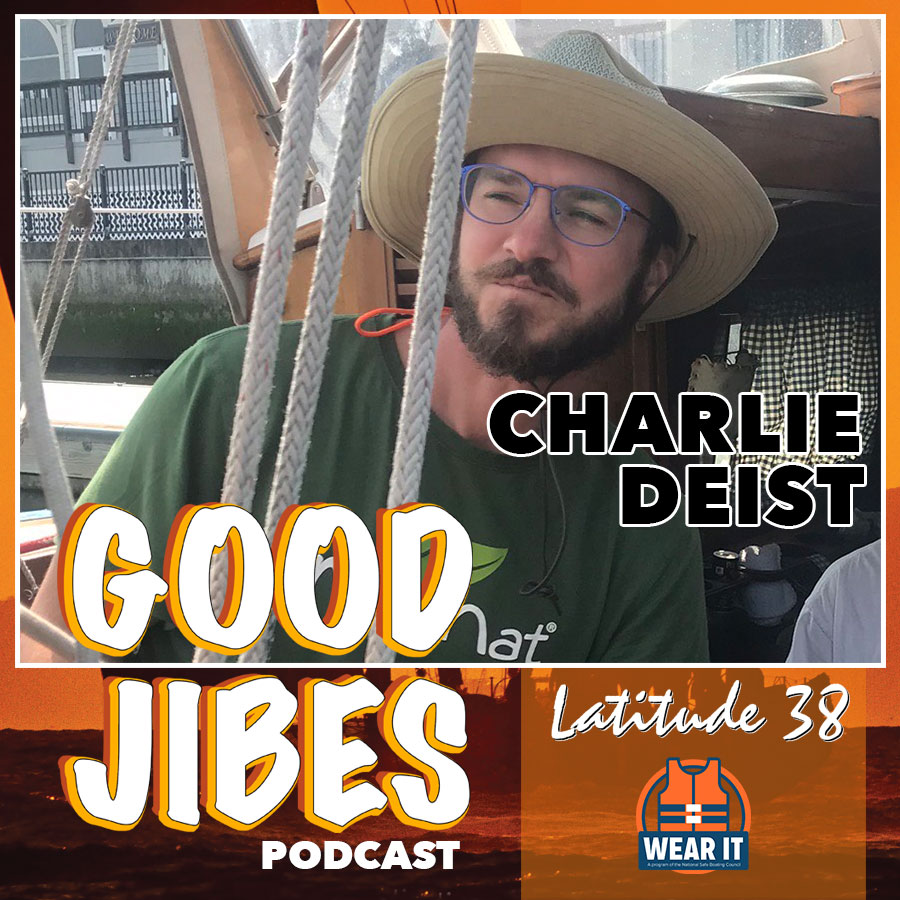
Episode 3: Chuck Hawley
Ryan Foland is joined by Chuck Hawley to discuss being a first-timer, safety tips, and the joys of sailing. Chuck was chairman of the US Sailing Safety-at-Sea Committee, has sailed over 40,000 miles on a range of vessels, and worked for West Marine for over 30 years. Hear how to approach your first offshore race, why it’s okay to be intimidated, how to find your community of sailors, West Coast vs. East Coast sailing, and how Chuck turned a depressing race into a joyful journey. This episode covers everything from Chuck’s storied sailing career to getting your captain’s license.
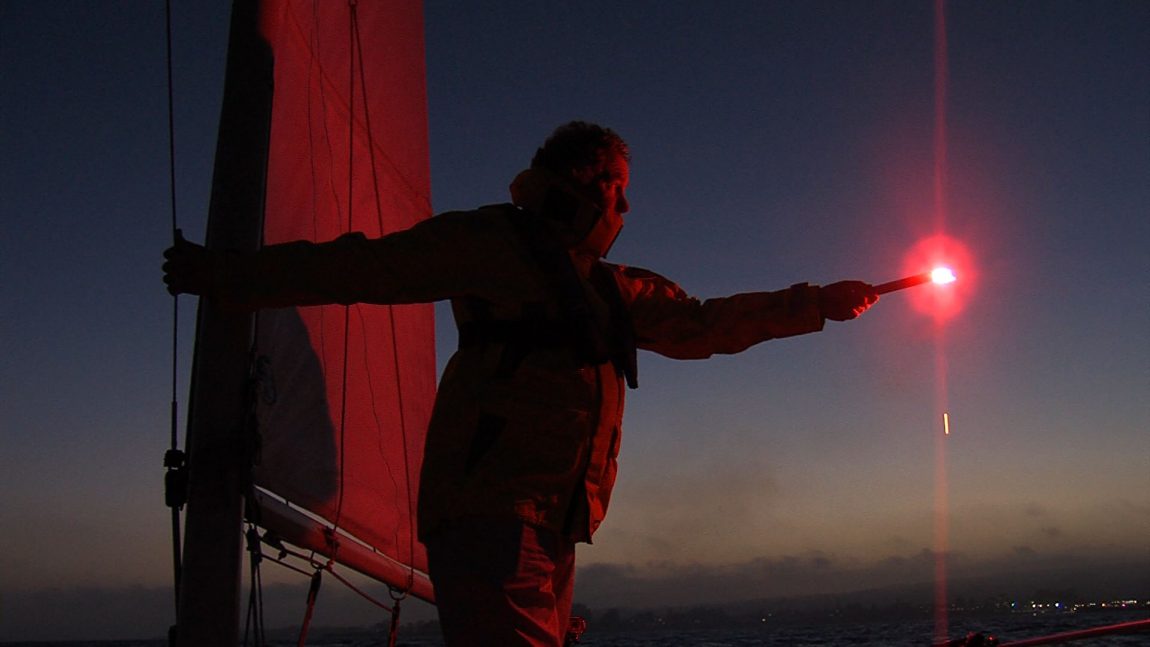
We look forward to sharing this new voyage with you. Check out our Good Jibes page to listen online and for links to your favorite podcast platform. Right now you can listen on Apple Podcasts and Spotify, and subscribe today!
If you have a sailor you would like us to interview or a story to share, email us at [email protected] and let us know! We see you all as navigators helping us chart our course forward. As Timothy Leary said, our podcast is a good thing to “Turn on, tune in, drop out.”
A Race Story with a Twist
Earlier this month, the sailboat Kahoots and her crew had just crossed the finish line in the OYRA Race Committee’s Choice #1 on August 14 — the sixth race of the 2021 OYRA series — when they came across an unusual sight. Kahoots crew member Dana Maddex-Carlucci was watching the fleet and witnessed Sapphire’s spinnaker working itself around the mast. With a camera (or phone) close at hand, Dana was able to grab a few quick shots of the situation as it ‘unfolded?’
Kahoots’ crew of captain Greg Mitchell, Dana Maddex-Carlucci, Jim Wheeler, John Amen, Parker Davis (guest “bow-dude”), Mark Phillips, Kate Mitchell (captain’s daughter) and Hendrik Bruhns witnessed Sapphire‘s unfortunate incident.
Dana wrote, “We finished with 24 knots of downwind and pulled our spinnaker down. I guess they did a beam reach and got overpowered.”
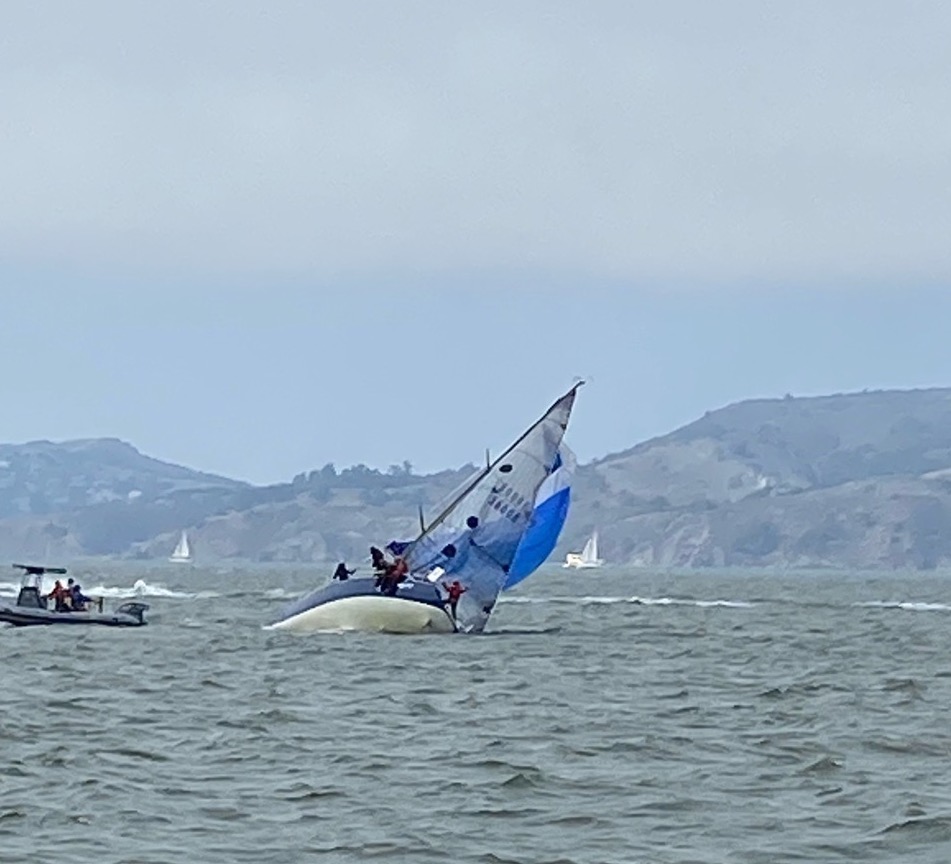
According to skipper Greg Mitchell’s description, Sapphire‘s wrap was right after the finish. “Hard to see in the photos but the foiling kitesurfers were having a regatta, and Sapphire’s knockdown drifted them close to their San Francisco line.”
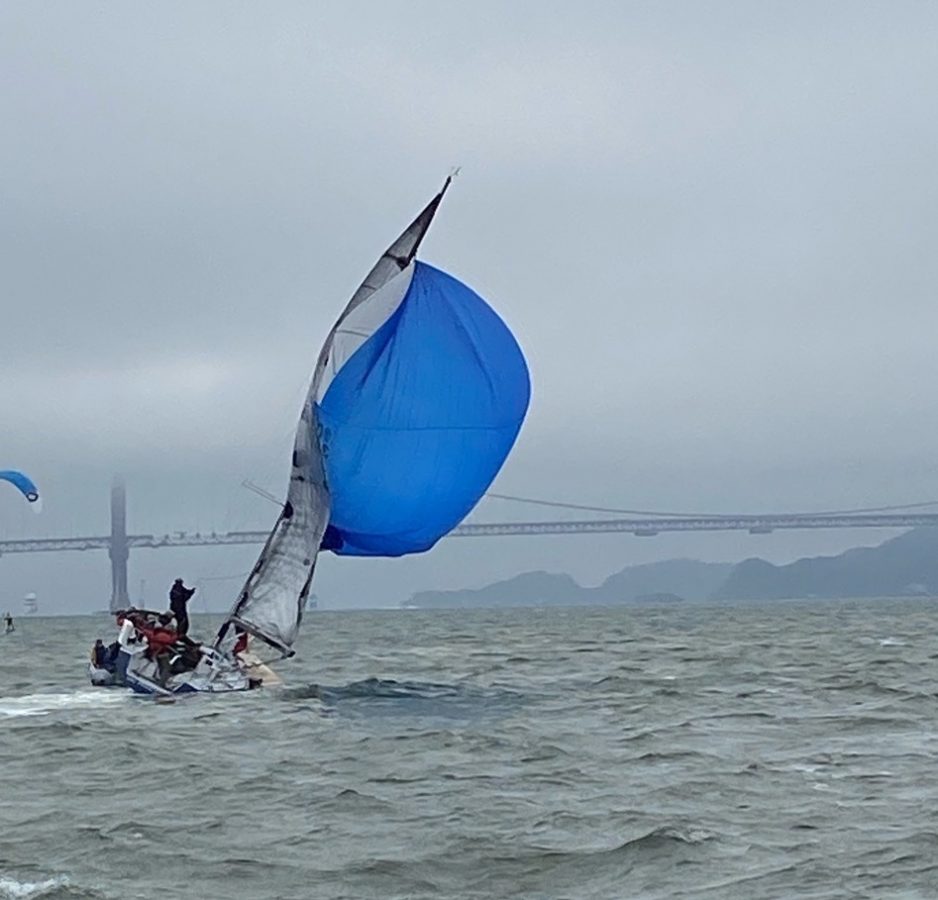
The race course was set to start and and finish in front of the Golden Gate Yacht Club, and Greg reported, “It was an ideal ocean race, with oscillating breeze from the northwest, almost directly upwind of the Gate, at 8-12 knots. A bit overcast, and cool on the way out.
“The ride home was simple: one jibe after the north entrance buoy, and then a jibe for the Gate. We fly assym kites on a traditional pole, so we can square back. The centerline-pole boats had a few more jibes to do. Was that same 8-12 [knots] until Bonita, where it was in the 15s. From the Gate to the finish it was mid- to high 20s.”

“We were able to dive under them,” Greg added, “but then decided to avoid drama, doused the kite, and tacked at Fort Mason for the reach back to Richmond. That’s when we went past Sapphire, to weather of Alcatraz and in the vicinity of the kitesurfer startline.
“Sapphire did really well — second on elapsed and first on corrected time. We were about four minutes behind Sapphire, hence the closeups.”
“On that specific day, we finished fourth over the line and fourth corrected. As of today, we’re leading the OYRA season, but this weekend is a two-race weekend at Drake’s Bay, and there are only three points between between first and fourth,” Greg added.
Kahoots will be racing with her Pacific Cup crew: Greg, skipper/navigator; Jim Wheeler, trimmer; John Amen, trimmer/pit; Miles Englehart, main; Miles’s teenage son Chase Englehart, bow; Mark Phillips, mast. “Kate (our usual pit and pit for Pac Cup) is off at college.”
As far as we are aware, no one aboard Sapphire was injured during the incident. We certainly hope the vessel and crew are back up and running, ready for this weekend’s race.
You can find more information about the OYRA series on the Yacht Racing Association’s website: https://yra.org/yra-racing/oyra-series.
Skippers Wanted: US Coast Guard-Licensed Captains for Charters and Private Lessons
Wanted: US Coast Guard-licensed captains for charters and private lessons. For power & sail. Hourly rate from $50 up. Weekend and weekday work available.
1160 Brickyard Cove Road, Suite 21, Richmond, California 94801 • (510) 236-2633 • [email protected]
Ronstan Bridge to Bridge: Familiar Faces in Familiar Places
Last night’s Ronstan Bridge to Bridge added the return of another spectacular Bay favorite after its cancellation in 2020. Run annually since 1998, this downwind drag race takes competitors just over six miles from a startline off the Marin shoreline a little west of the Golden Gate Bridge to a finish line off Yerba Buena Island by the Bay Bridge. It’s been a traditional Western shootout where competitors bring whatever they have to see who’s got the fastest weapon on the Bay.
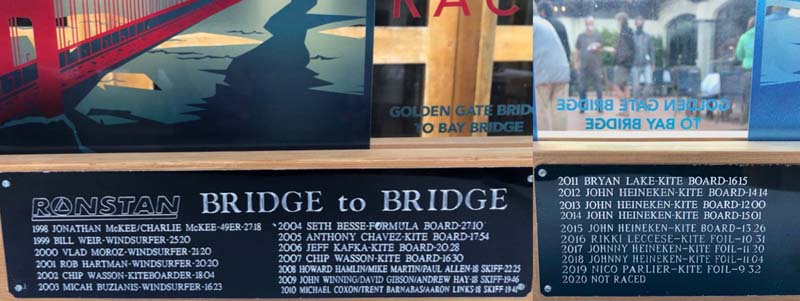
Over the years the race has included 49ers, Australian 18s, MOD70s, windsurfers, foiling and non-foiling multihulls, and all sorts of kite-powered boards. The plaques on the front and back sides of the perpetual trophy show winners from all those classes, but, in the last few years, it’s been clear that the winners, led by Johnny Heineken, are always going to be kites. Knowing it was a foregone conclusion that the winner would be a kite, the event has evolved to offer three classes: kites, windsurfers and, for the first time, wing sailing. This was also the first year that all entries were sailing on foils. Some might even think it was a foregone conclusion that Johnny Heineken would be the winner but, as the Olympics remind us, even world champions can have a bad day.
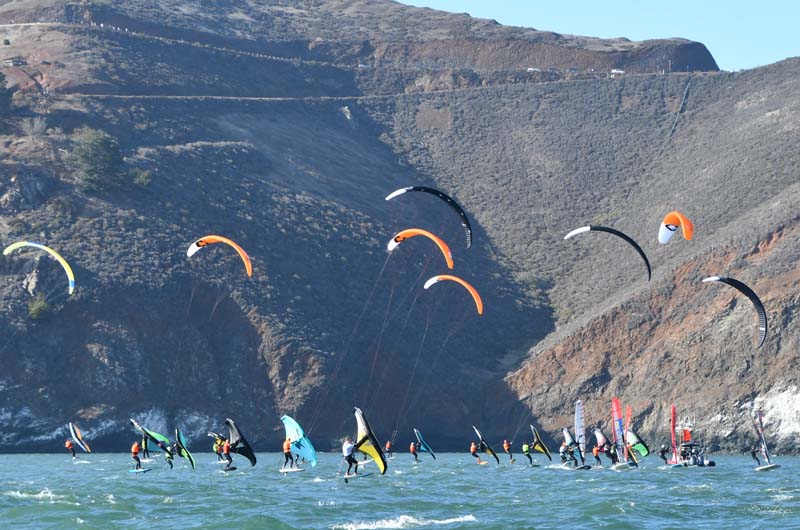
After a foggy, gray, smoke-filled month, the evening emerged as one of the best, though outside the Gate the wind hinted at being lighter than the usual summer blast. Colorful kites, wings and sails, along with fluorescent green and orange race jerseys (visible only when competitors weren’t up to their necks in water) combined with a frothy ebb current, bright blue sky and the Golden Gate Bridge towering overhead to leave the rest of the world’s dramas far behind.
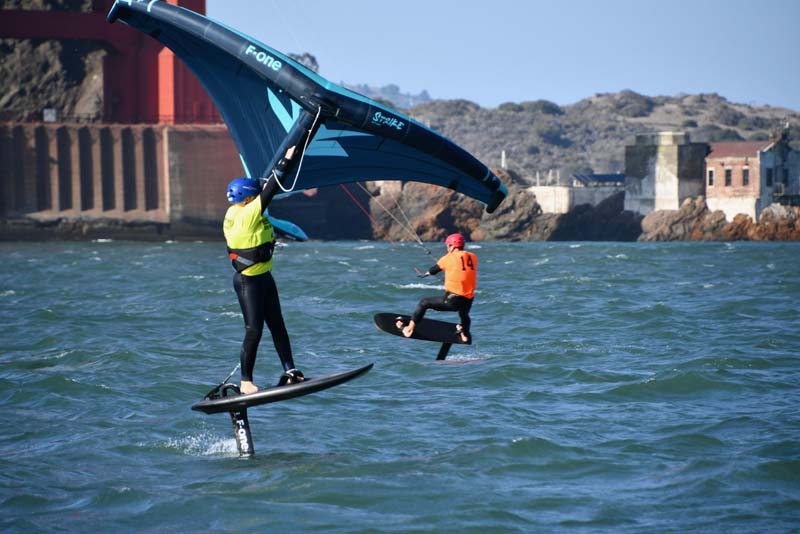
A three-minute starting sequence to the downwind start catapulted the eclectic, mixed fleet of 38 kites, wings and windsurfers off toward the Bay Bridge, and in minutes they were a dispersed group of fading fluorescent specks on the horizon. The favored strategy is to start near the committee boat on the Marin shore, as you’re going to be finishing on a starboard reach as you near the Bay Bridge. By starting to the north you hope to minimize the jibes on your way south — maneuvers in the choppy ebb are difficult, and foils are only fast when they’re upright above the water. Finishing first requires not falling.
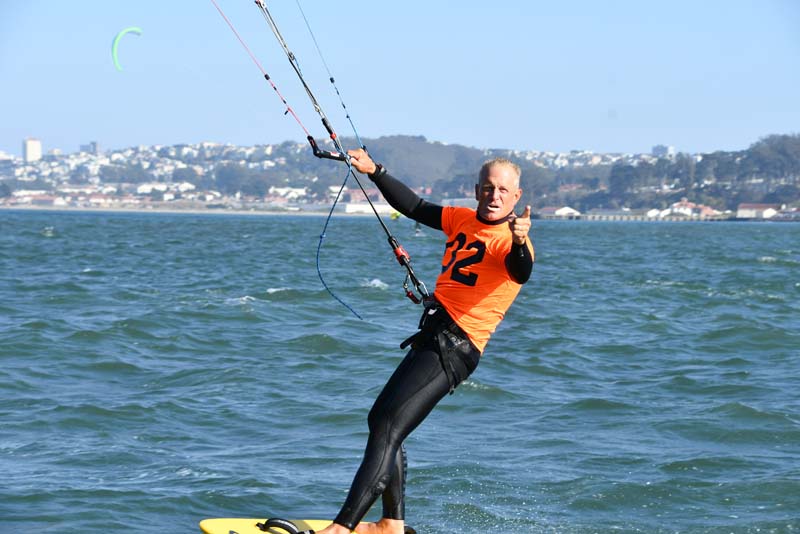
The St. Francis Yacht Club fleet of RIBs and committee boats dispersed like sheepdogs, trying to keep an eye out for wayward foils or lonesome heads as the Bay suddenly swallowed the once-dense fleet. We were aboard the pin end of the startline with Mike Mahoney and Richard Banthin charged with covering the western flank to make sure no one was swept out the Gate. After finishing off the Bay Bridge, the fleets head back toward the Crissy Field launch site, which is a long beat upwind, though most make pretty quick work of it. Kiters and windsurfers get to come back with the aid of a harness to take some of the load. For the wingers it’s all arms to keep your wing sailing.
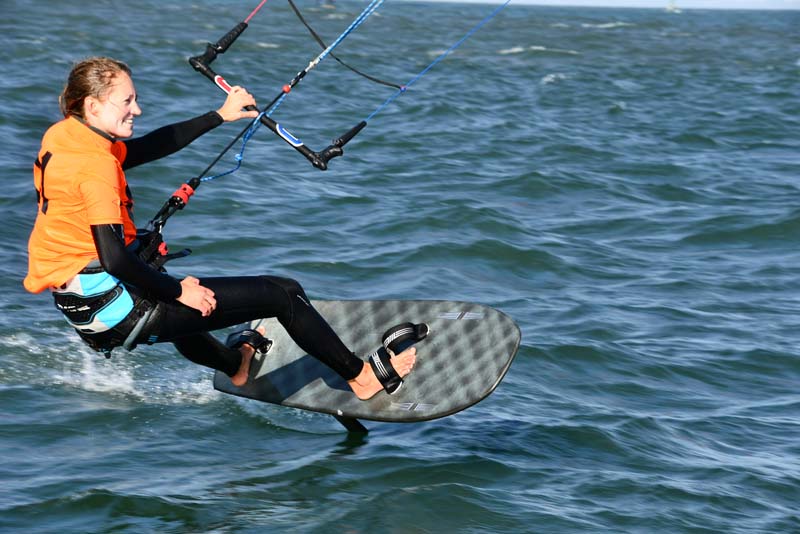
Racers gathered back at the St. Francis in the outdoor courtyard to await the final results, times and awards. Despite the ebb and choppy conditions, the times were fast. Olympic bronze medalist Jonathan McKee won the first Ronstan Bridge to Bridge in a 49er with a time of 27 minutes and 18 seconds. Nico Parlier set the overall record in 2019 on a foiling kite, with a time of 9 minutes, 32 seconds.
As Mike Martin explained, “The 2019 record was helped by a flood, but it’s not so much the current that helps but the flatter water. While foilers ride above the water, when you have a choppy ebb you have a better chance of your foil leaving the water, causing a crash. Floods help you focus on pure speed.”
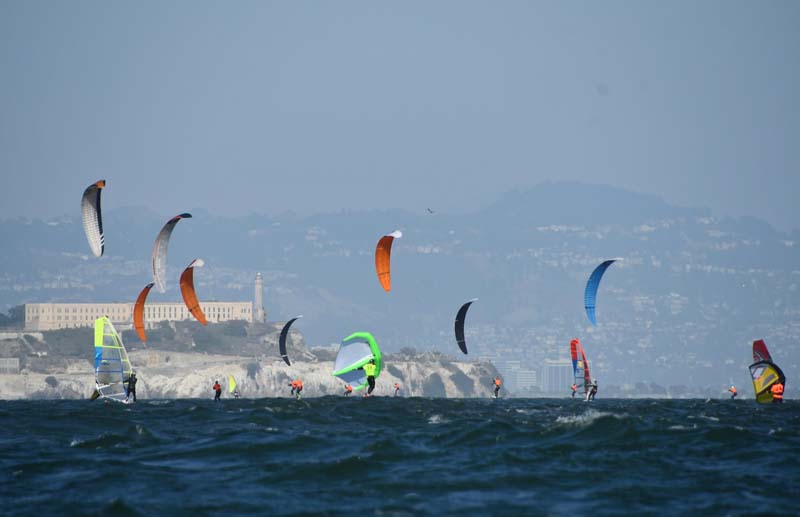
As the finish names and times were read off, it was apparent that kites still rule, windsurfers are fast and close, and wings are still evolving. This was the first year for wings to be part of the race, and they were fast and competitive. As StFYC commodore Bill Dana said, “Whatever you come up with next, we’ll figure out how to race them.”
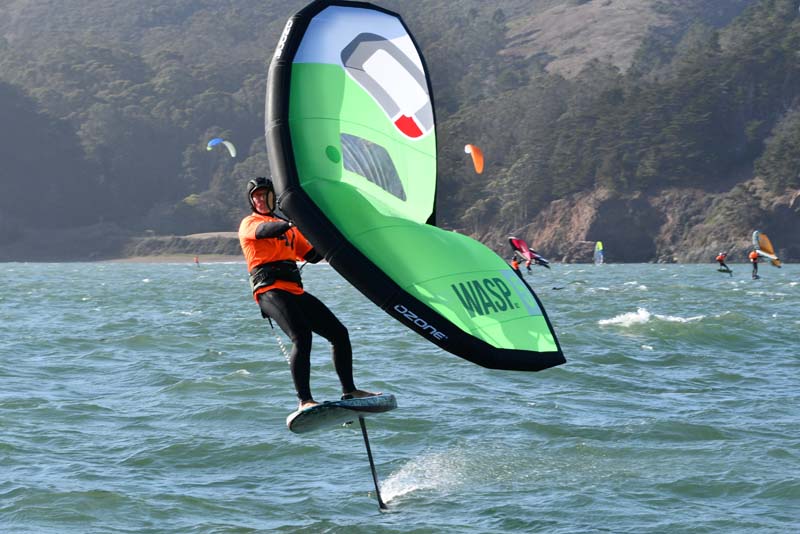
The winners of the three classes were Stefaans Viljoen in the wing class with a time of 19 minutes, 20 seconds; Xavier Ferlet in windsurfers with a time of 16 minutes, 10 seconds; and, in first place in the foiling kiteboards was Johnny Heineken, adding his name to the trophy for the seventh time with a blistering 10 minute, 32 second rocket ride in an ebb. 5O5 world champion Mike Martin was close behind in second, with Geoff Headington in third. The first female finisher was Johnny’s sister Erika in fifth.
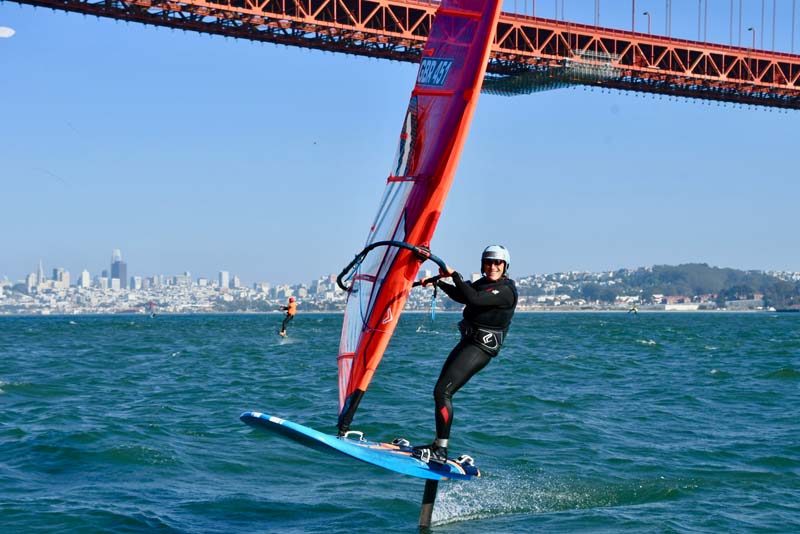
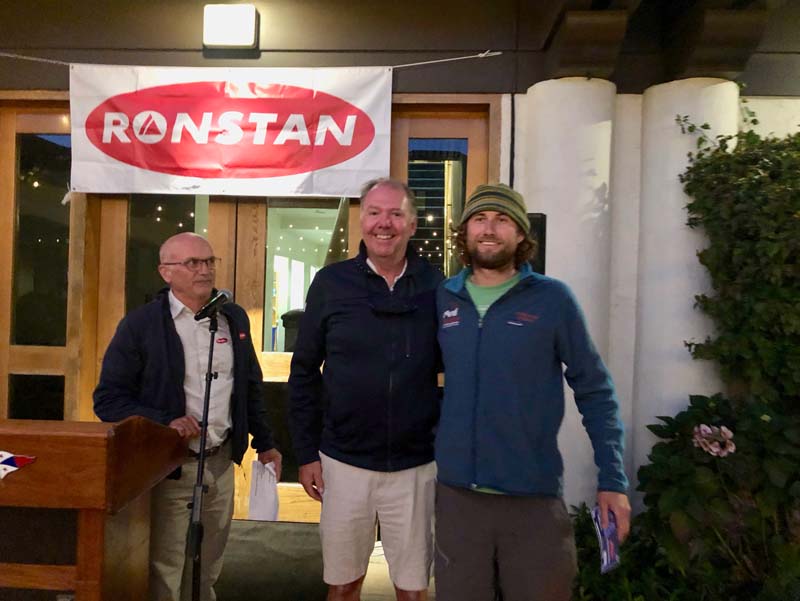
It was a spectacular night for this Bay classic. It’s fun to watch, though it’s a bit like standing on the side of the road for the Tour de France. They zip past and they’re gone, and you’re suddenly left in a quiet patch of empty water. Full Results Here.
About Next Month’s Doublehanded Farallones Race
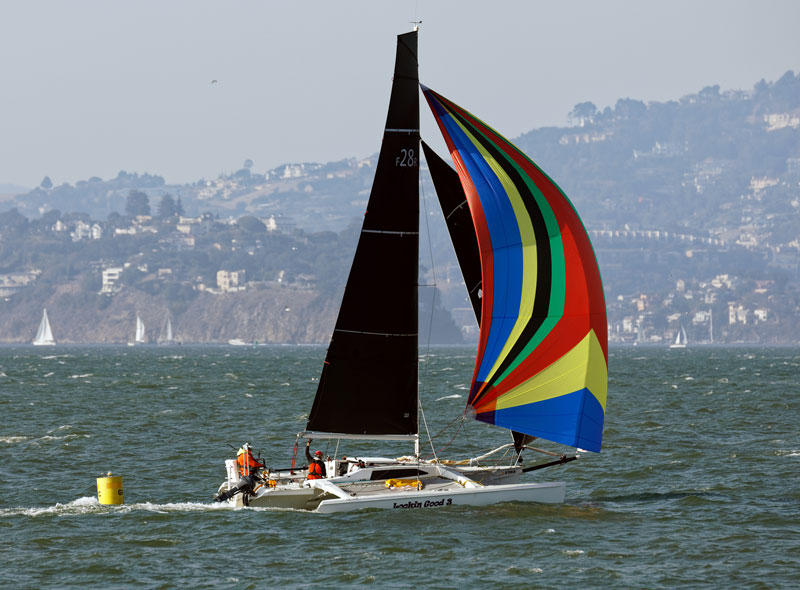
The Bay Area Multihull Association has incorporated some changes to the Doublehanded Farallones Race that harken back to the Farallon races run back in the early 1980s.
Race officer David Wilhite explains: “The DHF has always started and finished at Golden Gate Yacht Club, a diversion from the common-at-the-time Baker Beach start area, which had been traditionally used for more than 50 years. Shama Kota, who ran the first DHFs, never had a committee boat, so the GGYC deck worked. Over the years other groups have followed suit. Given the tidal issues encountered with close shore starts in the early mornings, BAMA typically had messy starting lines with fleets often overlapped simply trying to get across the start line.
“I’m not saying that Baker Beach is perfect. However, the two advantages are that you can get going to the ocean right up and nobody has to deal with the constriction between Lime and Fort Points, which can cut more than 30 minutes off time on course. Last year we tried the Baker Beach start, and the feedback we got from crews was very good. The parking lot directly behind the start area provided an excellent place from which to spectate.
“Another change we implemented last year was to partner with the San Francisco [Ham] Radio Club to boost our ability to communicate with competitors. The three advantages we gained are ability to listen and to reliably transmit all the way out to the SE Farallones. Importantly, radio communication is more consistent because of the Ham operator’s experience. Finally it relieves the race committee so that we can better focus on race administration. We are now able to reliably use VHF radios, which has always been an issue.
“Finally, we have allowed competitors to round the SE Farallones in either direction. This may sound like a small thing but the original Farallon race (run by San Francisco YC) always allowed the option. In many cases it pays well to round in a clockwise direction. Although I’m not totally sure about this, the BAMA option of a counterclockwise rounding only stemmed from the thought that multihulls can’t tack easily in a seaway, so the limitation was made. Today’s multihulls not only point well, they also can tack easily. So we thought, why not open up the tactical option?
“One thing that Truls Myklebust has been big on is posting results as soon as possible. To that end he’s mastered posting results on the fly, almost in real time. It’s pretty awesome to watch him smile as he does the updates.
“BAMA has dropped our unique safety requirements and adopted OYRA safety regulations. This has made it easier for competitors to outfit their boats and eased the USCG permit process.
“On the note of safety, two years ago we implemented random safety checks by drawing names from a hat and announcing during finish procedures what specific boats had been picked. I felt this was a huge success. Three of the four boats passed; one failed only to have a 20% time penalty assessed. So that the inspectees didn’t feel picked on, we awarded each a brand-new thermos filled with hot tea (not spiked unfortunately). One of the great things that’s come out of this is that competitors have called us to pre-inspect their boats so as to avoid the lottery, which I love because I get to clamber on boats and meet with owners. What can be better than talking about sailing?
“Jibeset has been running experiments on AIS position posting, which I think is really cool. However we need more boats to install transceivers. The Yacht Racing Association has proposed that all boats have AIS transceivers by 2025; we in BAMA are talking about implementing that plan at least a year sooner. To have AIS information from boats on the course is a huge advantage in terms of safety and tracking. We also feel it would be good to have transceivers running so that ship traffic sees a positive ping rather than relying on radar reflectors. I imagine their plotters will light up.
“With the loss of life and boats over the 40+ years of racing, Truls and I are committed to keeping the race cool and safe, avoiding the paranoid safety reactions of the last decade, and focusing on solid preparation and competent seamanship.”
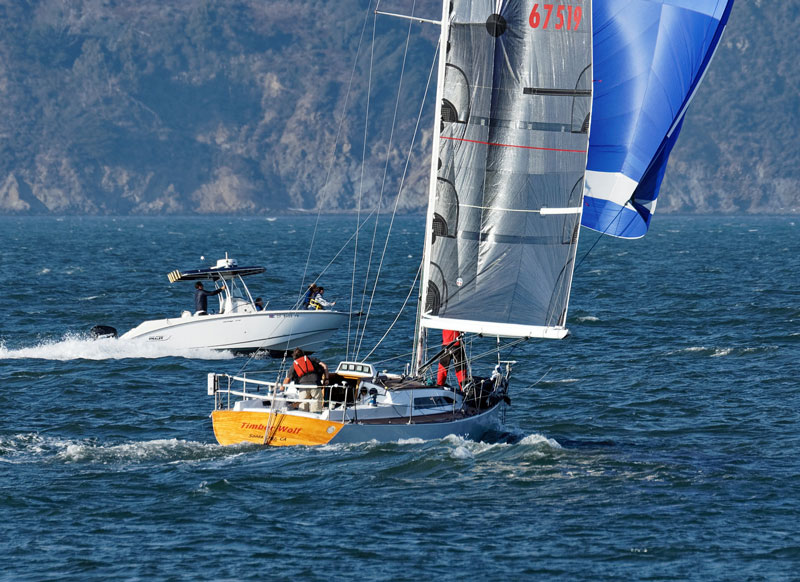
This year’s race will be held on September 25. The registration fee will be $70 until August 31; thereafter it will be $80. No entries will be accepted after 9 p.m. on September 23. Go to Jibeset to sign up, and learn more at https://sfbama.org.
Climb Aboard for Latitude 38’s September Crew List Party!
Join us for an evening of fun, merriment and general chit-chat about everyone’s favorite topic. Oh, and you can also find crew or a boat to sail aboard.
Put your name on Latitude 38‘s Crew List, then get your ticket for the party-est party of the year!
Note: When purchasing tickets as a Baja Ha-ha skipper or first mate, click on the link for Tickets and it will take you to the next window where you will see two options — General Admission $10.00, Baja Ha-Ha Skipper & First Mate $0.00. Select the Baja Ha-Ha option to ‘purchase’ your ticket. It will not ask you for any payment.


